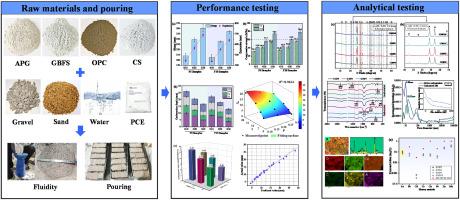Carbonation behavior and performance optimization of anhydrous phosphogypsum-based concrete: synergistic effect of admixtures
IF 5.8
2区 化学
Q2 CHEMISTRY, MULTIDISCIPLINARY
引用次数: 0
Abstract
During the service life of concrete, carbonation is an inevitable phenomenon. This study innovatively developed a novel anhydrous phosphogypsum-based concrete (APGC) using anhydrous phosphogypsum (APG) as the primary cementitious material, synergistically combined with granulated blast furnace slag (GBFS), ordinary Portland cement (OPC), and carbide slag (CS), addressing the low utilization rate of industrial solid wastes. The carbonation performance was systematically evaluated through multi-scale characterizations (FTIR, XRD, SEM-EDS, MIP), accompanied by the first integrated environmental risk assessment of heavy metal leaching and carbon emissions for such materials. APGC exhibits exceptional high-fluidity (spread flow diameter up to 690 mm), high-strength (28-day compressive strength 78.6 MPa), and superior water resistance (softening coefficient 0.92, water absorption rate 0.74 %), enabled by GBFS-OPC synergies enhancing matrix density and alkalinity. Carbonation led to the decomposition of ettringite and the decalcification of C-S-H gel in APGC, as well as an increase in the proportion of harmful pores and porosity, resulting in APGC deterioration. A Fick's first law-based carbonation prediction model shows <10 % error, enabling service life prediction of APGC. Carbonation disrupted the chemical speciation of heavy metals in APGC, leading to increased leaching of heavy metals., yet APGC reduces carbon emissions by 49.8 % compared to conventional C60 concrete. The optimal mix design (30 % GBFS, 2 % CS, ≥5 % OPC) is expected to reduce the use of traditional Portland cement, pioneering exploration of APGC carbonation behavior and filling the research gap in phosphogypsum-based concrete durability.

无水磷石膏基混凝土的碳化行为及性能优化:外加剂的协同效应
在混凝土使用寿命期间,碳化是一种不可避免的现象。本研究以无水磷石膏(APG)为主要胶凝材料,与粒状高炉矿渣(GBFS)、普通硅酸盐水泥(OPC)、电石渣(CS)协同结合,创新开发了一种新型无水磷石膏基混凝土(APGC),解决了工业固体废弃物利用率低的问题。通过多尺度表征(FTIR、XRD、SEM-EDS、MIP)对碳化性能进行了系统评价,并首次对该材料的重金属浸出和碳排放进行了综合环境风险评估。由于GBFS-OPC协同作用增强了基质密度和碱度,APGC具有优异的高流动性(流动直径可达690 mm)、高强度(28天抗压强度78.6 MPa)和优异的耐水性(软化系数0.92,吸水率0.74%)。碳酸化作用导致APGC中钙矾石分解,C-S-H凝胶脱钙,有害孔隙和孔隙比例增加,导致APGC变质。基于菲克第一定律的碳酸化预测模型误差为10%,实现了APGC寿命预测。碳酸化破坏了APGC中重金属的化学形态,导致重金属的浸出增加。然而,与传统的C60混凝土相比,APGC减少了49.8%的碳排放。最佳配合比设计(30% GBFS, 2% CS,≥5% OPC)有望减少传统波特兰水泥的使用,开拓APGC碳化行为的探索,填补磷石膏基混凝土耐久性的研究空白。
本文章由计算机程序翻译,如有差异,请以英文原文为准。
求助全文
约1分钟内获得全文
求助全文
来源期刊

Sustainable Chemistry and Pharmacy
Environmental Science-Pollution
CiteScore
8.20
自引率
6.70%
发文量
274
审稿时长
37 days
期刊介绍:
Sustainable Chemistry and Pharmacy publishes research that is related to chemistry, pharmacy and sustainability science in a forward oriented manner. It provides a unique forum for the publication of innovative research on the intersection and overlap of chemistry and pharmacy on the one hand and sustainability on the other hand. This includes contributions related to increasing sustainability of chemistry and pharmaceutical science and industries itself as well as their products in relation to the contribution of these to sustainability itself. As an interdisciplinary and transdisciplinary journal it addresses all sustainability related issues along the life cycle of chemical and pharmaceutical products form resource related topics until the end of life of products. This includes not only natural science based approaches and issues but also from humanities, social science and economics as far as they are dealing with sustainability related to chemistry and pharmacy. Sustainable Chemistry and Pharmacy aims at bridging between disciplines as well as developing and developed countries.
 求助内容:
求助内容: 应助结果提醒方式:
应助结果提醒方式:


